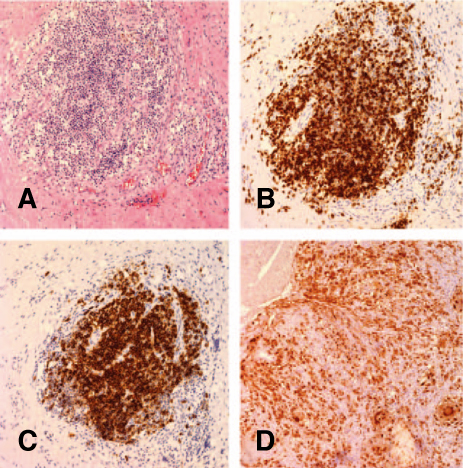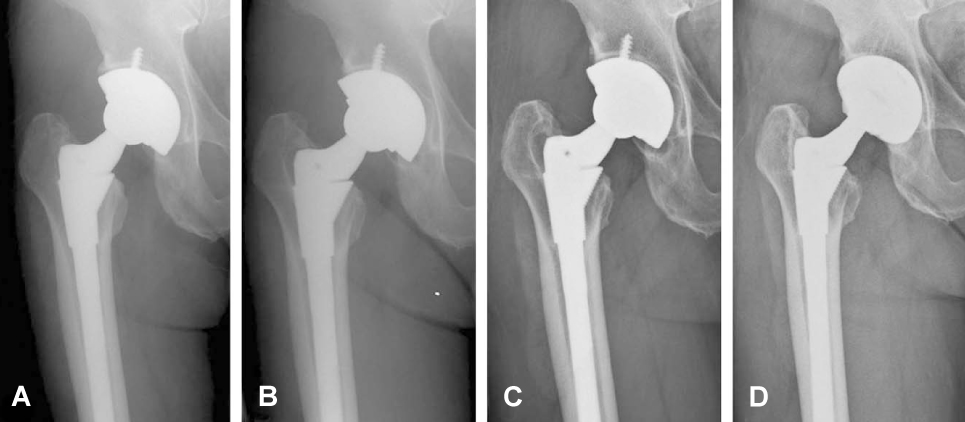J Korean Hip Soc.
2010 Sep;22(3):171-176. 10.5371/jkhs.2010.22.3.171.
Metal-on-Metal Bearing in Total Hip Arthroplasty
- Affiliations
-
- 1Department of Orthopedic Surgery, Samsung Medical Center, Sungkyunkwan University School of Medicine, Seoul, Korea. ysp3504@skku.edu
- KMID: 1461166
- DOI: http://doi.org/10.5371/jkhs.2010.22.3.171
Abstract
- Metal-on-metal bearings have been reintroduced with the improved materials, design and manufacturing quality control as an alternative to the conventional metal-on-polyethylene articulation. The advantages of total hip arthroplasty using a metal-on-metal bearing include an extremely low wear rate, a very small risk of in vivo fracture and the use of a larger femoral head. These advantages have led to an increased use of metal-on-metal bearings for younger and more active patients with advanced hip disease. Concerns remain regarding the elevated levels of metal ions and their potential consequences such as metal hypersensitivity or potential carcinogenesis.
Figure
Reference
-
1. Amstutz HC, Grigoris P. Metal on metal bearings in hip arthroplasty. Clin Orthop Relat Res. 1996. 329:Suppl. S11–S34.
Article2. August AC, Aldam CH, Pynsent PB. The McKee-Farrar hip arthroplasty. A long-term study. J Bone Joint Surg Br. 1986. 68:520–527.
Article3. Clarke MT, Darrah C, Stewart T, Ingham E, Fisher J, Nolan JF. Long-term clinical, radiological and histopathological follow-up of a well-fixed McKee-Farrar metal-on-metal total hip arthroplasty. J Arthroplasty. 2005. 20:542–546.
Article4. Visuri T. Long-term results and survivorship of the McKee-Farrar total hip prosthesis. Arch Orthop Trauma Surg. 1987. 106:368–374.
Article5. Amstutz HC, Beaulé PE, Dorey FJ, Le Duff MJ, Campbell PA, Gruen TA. Metal-on-metal hybrid surface arthroplasty: two to six-year follow-up study. J Bone Joint Surg Am. 2004. 86:28–39.
Article6. Daniel J, Pynsent PB, McMinn DJ. Metal-on-metal resurfacing of the hip in patients under the age of 55 years with osteoarthritis. J Bone Joint Surg Br. 2004. 86:177–184.
Article7. Schmidt M, Weber H, Schön R. Cobalt chromium molybdenum metal combination for modular hip prostheses. Clin Orthop Relat Res. 1996. 329:Suppl. S35–S47.
Article8. McKellop H, Park SH, Chiesa R, et al. In vivo wear of three types of metal on metal hip prostheses during two decades of use. Clin Orthop Relat Res. 1996. 329:Suppl. S128–S140.9. Schey JA. Systems view of optimizing metal on metal bearings. Clin Orthop Relat Res. 1996. 329:Suppl. S115–S127.
Article10. Kim SY, Kyung HS, Ihn JC, Cho MR, Koo KH, Kim CY. Cementless Metasul metal-on-metal total hip arthroplasty in patients less than fifty years old. J Bone Joint Surg Am. 2004. 86:2475–2481.
Article11. Smith SL, Dowson D, Goldsmith AA. The effect of femoral head diameter upon lubrication and wear of metal-on-metal total hip replacements. Proc Inst Mech Eng H. 2001. 215:161–170.
Article12. Silva M, Heisel C, Schmalzried TP. Metal-on-metal total hip replacement. Clin Orthop Relat Res. 2005. 430:53–61.
Article13. Sieber HP, Rieker CB, Köttig P. Analysis of 118 second-generation meta-on-metal retrieved hip implants. J Bone Joint Surg Br. 1999. 81:46–50.14. Dorr LD, Wan Z, Longjohn DB, Dubois B, Murken R. Total hip arthroplasty with use of the Metasul metal-on-metal articulation. Four to seven-year results. J Bone Joint Surg Am. 2000. 82:789–798.
Article15. Grübl A, Marker M, Brodner W, et al. Long-term follow-up of metal-on-metal total hip replacement. J Orthop Res. 2007. 25:841–848.
Article16. Jacobs JJ, Skipor AK, Patterson LM, et al. Metal release in patients who have had a primary total hip arthroplasty. A prospective, controlled, longitudinal study. J Bone Joint Surg Am. 1998. 80:1447–1458.
Article17. Brodner W, Bitzan P, Meisinger V, Kaider A, Gottsauner-Wolf F, Kotz R. Serum cobalt levels after metal-on-metal total hip arthroplasty. J Bone Joint Surg Am. 2003. 85:2168–2173.
Article18. Savarino L, Greco M, Cenni E, et al. Differences in ion release after ceramic-on-ceramic and metal-on-metal total hip replacement. Medium-term follow-up. J Bone Joint Surg Br. 2006. 88:472–476.19. Daniel J, Ziaee H, Pradhan C, Pynsent PB, McMinn DJ. Renal clearance of cobalt in relation to the use of metal-on-metal bearings in hip arthroplasty. J Bone Joint Surg Am. 2010. 92:840–845.
Article20. Gillespie WJ, Henry DA, O'Connell DL, et al. Development of hematopoietic cancers after implantation of total joint replacement. Clin Orthop Relat Res. 1996. 329:Suppl. S290–S296.
Article21. Visuri T, Pukkala E, Paavolainen P, Pulkkinen P, Riska EB. Cancer risk after metal on metal and polyethylene on metal total hip arthroplasty. Clin Orthop Relat Res. 1996. 329:Suppl. S280–S289.
Article22. Tharani R, Dorey FJ, Schmalzried TP. The risk of cancer following total hip or knee arthroplasty. J Bone Joint Surg Am. 2001. 83:774–780.
Article23. Ladon D, Doherty A, Newson R, Turner J, Bhamra M, Case CP. Changes in metal levels and chromosome aberrations in the peripheral blood of patients after metal-on-metal hip arthroplasty. J Arthroplasty. 2004. 19:Suppl. 78–83.
Article24. Dunstan E, Ladon D, Whittingham-Jones P, Carrington R, Briggs TW. Chromosomal aberrations in the peripheral blood of patients with metal-on-metal hip bearings. J Bone Joint Surg Am. 2008. 90:517–522.
Article25. Hur CI, Yoon TR, Cho SG, Song EK, Seon JK. Serum ion level after metal-on-metal THA in patients with renal failure. Clin Orthop Relat Res. 2008. 466:696–699.
Article26. Ziaee H, Daniel J, Datta AK, Blunt S, McMinn DJ. Transplacental transfer of cobalt and chromium in patients with metal-on-metal hip arthroplasty: a controlled study. J Bone Joint Surg Br. 2007. 89:301–305.27. Rieker CB, Schön R, Köttig P. Development and validation of a second-generation metal-on-metal bearing: laboratory studies and analysis of retrievals. J Arthroplasty. 2004. 19:Suppl. 5–11.
Article28. Willert HG, Buchhorn GH, Fayyazi A, et al. Metal-on-metal bearings and hypersensitivity in patients with artificial hip joints. A clinical and histomorphological study. J Bone Joint Surg Am. 2005. 87:28–36.
Article29. Davies AP, Willert HG, Campbell PA, Learmonth ID, Case CP. An unusual lymphocytic perivascular infiltration in tissues around contemporary metal-on-metal joint replacements. J Bone Joint Surg Am. 2005. 87:18–27.
Article30. Park YS, Moon YW, Lim SJ, Yang JM, Ahn G, Choi YL. Early osteolysis following second-generation metal-on-metal hip replacement. J Bone Joint Surg Am. 2005. 87:1515–1521.
Article31. Milosev I, Trebse R, Kovac S, Cör A, Pisot V. Survivorship and retrieval analysis of Sikomet metal-on-metal total hip replacements at a mean of seven years. J Bone Joint Surg Am. 2006. 88:1173–1182.
Article32. Korovessis P, Petsinis G, Repanti M, Repantis T. Metallosis after contemporary metal-on-metal total hip arthroplasty. Five to nine-year follow-up. J Bone Joint Surg Am. 2006. 88:1183–1191.33. Pandit H, Glyn-Jones S, McLardy-Smith P, et al. Pseudotumours associated with metal-on-metal hip resurfacings. J Bone Joint Surg Br. 2008. 90:847–851.
Article
- Full Text Links
- Actions
-
Cited
- CITED
-
- Close
- Share
- Similar articles
-
- Metal-on-metal Articulation of Total Hip Replacement
- Second-Generation Metal-on-Metal Total Hip Arthroplasty
- Metal Debris Induced Osteolysis after Cementless Total Hip Arthroplasty: One case report
- Arthroplasty in Femoral Head Osteonecrosis
- Cementless Total Hip Arthroplasty using Metal on Metal Articulation



